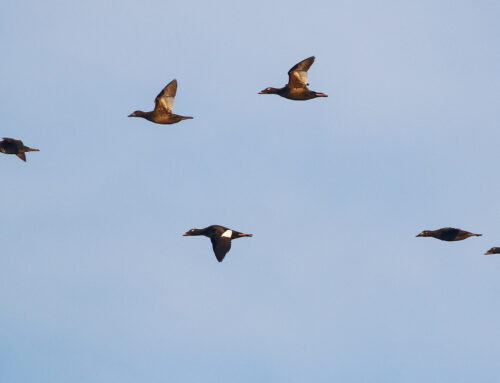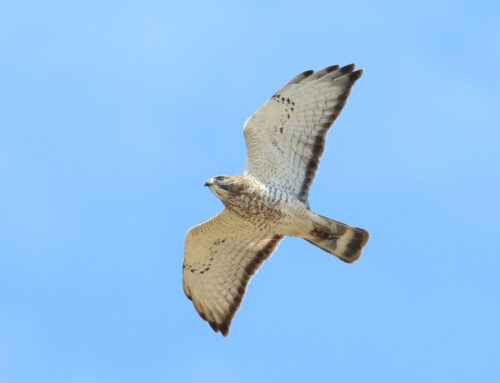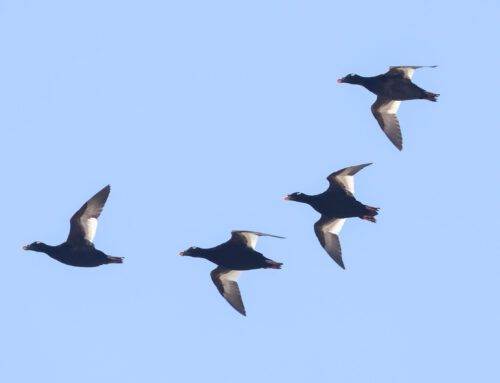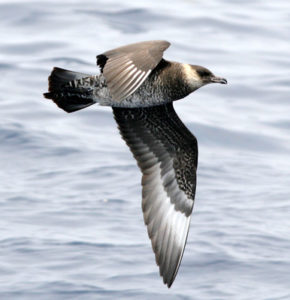
Pomarine Jaeger by cotinis on Flickr
There are few words that can bring immediate focus to a group of avid birders. Typically we’re occupied with scanning the horizon, looking in every direction, actively listening for chips and chirps and in general trying to take in everything from every angle. The more eyes and ears the more we’ll be able to catch and the more experience we’ll be able to draw from. When someone utters the word “jaeger” though, the focus switches. We all rush to locate the bird and a silence ensues that lasts until the bird leaves. We all want to experience as much of this sighting as we can.
Jaegers are phenomenal birds, there’s just no way around it. Their name translates from German to hunter, highlighting their mastery of chasing down other seabirds. Yet jaegers aren’t typically out to kill the birds they’re chasing, but to kleptoparasitize them. This practice, harassing another bird in order to steal its hard-earned catch, isn’t particular to jaegers but perfected by them. Anyone who has seen the frenzy of gulls chasing the one that got a french-fry can attest to the prevalence of bullying and stealing in seabirds, but the Parasitic Jaeger takes in more of its food via this practice than any other known seabird. Watching them, their proficiency in this practice is undeniable. When a Parasitic Jaeger hones in on a target they often switch to a driven and powerful flight akin to a Peregrine Falcon. An aerial melee ensues where the jaeger showcases its agility and skill on the wing. If successful, the targeted bird will disgorge its food and hurry away, leaving its catch for the jaeger. Parasitic Jaegers are not known for giving up these chases, to note.
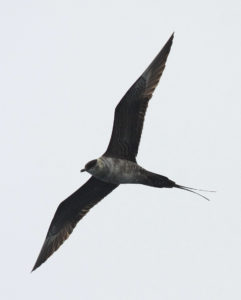
Long-tailed Jaeger by seabamirum on Flickr
The benefits of this behavior are several. Many seabirds have specialized feeding strategies so they can obtain prey that other seabirds can’t — carving out a feeding niche potentially specialized for them. This approach has obvious advantages, but if instead of having your own niche you’re an expert at stealing from everyone, you can exploit all the different food sources utilized by your targets giving you access to a wide variety of foods. As Banksy said, “If you’re good at cheating, you don’t have to be good at anything else.”
It’s not only the beauty of jaegers that draws us in but the challenge as well. According to Howell and Zufelt in Oceanic Birds of the World, field ID is often challenging and many skuas are not safely identified to species in the field. The three species of jaegers, all in skua family and genus Stercorarius (meaning “of dung,” owing to the initial idea that the birds pursued by jaegers were disgorging dung, not food), have all been seen at Whitefish Point over the years. Despite that we’ve had over 25 jaegers fly by so far this season, only a handful have been identified to the species level. The birds we do see are often very distant and/or juveniles who lack some of the characteristic plumages used to confirm an identification. Observations are often short and challenging, with birders taking in as many details as we can in the short window of time we see these migrants. Behavior and flight patterns are often a great supplement to identification, but variable enough that they usually can’t be solely relied upon.
The sight of a jaeger is always a special one. Not only are they beautiful birds, but exciting to watch due to their aerial prowess and specialized behaviors. The frequency with which we see them at Whitefish Point is yet another reason this is such a remarkable place.
Featured photo: Parasitic Jaeger at WPBO © Eric Ripma
Text by Fall Waterbird Counter Steve Backus


